Report to the Congress on the Effect of Capital Rules on Mortgage Servicing Assets
- Preface
- Executive Summary
- Background
- Risks to Firms Holding Mortgage Servicing Assets
- Role of Mortgage Servicing Assets in Bank Failures
- Regulatory Approaches for Mortgage Servicing Assets
- Evolution of the Mortgage Servicing Market since 1998
- Potential Impact of the Revised Capital Rule on the Mortgage Servicing Business
- Potential Impact of the Revised Capital Rule on Nonbanks
Evolution of the Mortgage Servicing Market since 1998
The evolution of the market for MSAs has been shaped by a variety of factors. Over the time period considered in this section--1998 to 2015--these factors include
- changes in interest rates, as well as an extended period of historically low interest rates;
- the sharp rise and fall in house prices, and the corresponding changes in mortgage debt and surge in nonperforming loans;
- changes in firms' interest in serving as aggregators by purchasing the servicing rights and originations of other firms;
- shifts in the incentives to securitizing mortgages versus holding them in portfolio; and
- regulatory, tax, and accounting changes related to mortgage servicing.
As reflected in figure 5, total bank MSA valuations increased from roughly $20 billion in 1998 to nearly $78 billion at the end of the third quarter of 2008.50 MSA values dropped 33 percent in the fourth quarter of 2008 at the height of the crisis, fell significantly further in 2011 and 2012 and have since hovered between $30 billion and $40 billion.51 This measure includes only the MSA holdings of banks, and does not include savings associations.52 Savings associations were excluded because they were primarily supervised by the former Office of Thrift Supervision (OTS) prior to July 2011, and therefore filed Thrift Financial Reports (TFRs) rather than the Call Reports filed by banks.53 The TFR data did not align sufficiently well with the Call Report data to create a consistent time series that combined both types of institutions. Although savings associations began filing Call Reports in 2012 after their supervision was transferred from the OTS to the OCC or FDIC, depending on an institution's charter, savings associations were excluded from the analysis for the entire time period for consistency. The assets of savings associations that failed and were acquired by banks will, however, appear in the Call Report data. The implications of this consistency issue are discussed later in this report.
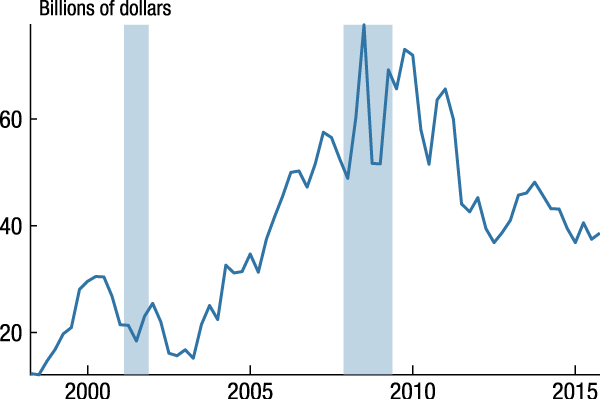
Note: Shaded areas indicate recessions as defined by the National Bureau of Economic Research (NBER).
Source: Staff calculations from Call Report data.
Factors Determining Fluctuations of MSA Values Held by Banks
In this Section:
The fluctuations in banks' MSA holdings reflect several factors. To set the stage, 1996 was the first full year in which GAAP permitted the recognition of an MSA associated with loans a bank originated and sold, but for which it retained the servicing. This accounting development may have given banks an incentive to conduct business in a way that gave rise to MSAs. From the second quarter of 1998, the beginning of the time series data considered in this report, to the third quarter of 2008, banks' MSA holdings rose because of an increase in mortgage debt outstanding, as well as an increase in the share of mortgages that were securitized. During the financial crisis, banks' MSA holdings increased further as nonbank servicers withdrew from the market in response to funding and liquidity pressures. Post-crisis, banks have decreased their MSA holdings, reflecting a contraction in mortgage debt outstanding, a decline in MSA valuations due to the fall in interest rates, and an increase in nonbank market share. The increase in nonbank market share appears most directly attributable to a number of significant nonbank acquisitions of crisis-era legacy servicing portfolios of large banking institutions, as well as an increase in the nonbank market share in the mortgage origination market, and more indirectly from several regulatory changes and policy actions.
Mechanically, MSA holdings are equal to the price (or "multiple") the firm is willing to pay to service one dollar of UPB, times the servicing fee, times the UPB of the mortgages that a firm is servicing for others. In other words:
MSA holdings = multiple*servicing fee*UPB.
The following sections describe the factors that have affected two of these components--the multiple and the UPB--of bank MSA holdings during the past years.
Changes in MSA Multiple
Firms determine how much they are willing to pay to service a given portfolio of loans based on their valuation models, which, as described earlier, forecast the value of servicing based on assumptions about interest rates, default probabilities, and other factors. A firm might decide, for example, that it is willing to pay $2,000 to service a $200,000 mortgage that comes with a 0.25 percentage point servicing fee. The multiple--which is 4 in this example--is backed out of the overall $2,000 valuation as follows:
4 = $2,000 / ($200,000*0.25%)
The MSA multiple thus serves as a shorthand metric for firms to compare the value of MSAs across portfolios and over time. A rise in the multiple, therefore, means that a firm is willing to pay more to service a given portfolio, or alternatively, that servicing those loans is perceived as being more valuable.
Historically, MSA multiples have increased when interest rates rise, and, conversely, have declined when interest rates fall. This relationship holds because an increase in interest rates typically equates to a decrease in prepayment, which means that the firm will be receiving the servicing fee on the mortgage for a longer period of time. To illustrate this point,
figure 6 displays two measures of MSA multiples for the 2007 to 2015 period for 30-year, fixed-rate mortgages eligible for a GSE guarantee. One measure is an estimated multiple for a hypothetical servicing portfolio of newly originated mortgages with a 25 basis point servicing strip.54 The other measure is the average of the multiples that a group of banks and savings associations used to value their existing books of mortgages serviced for others. These banks and savings associations in total serviced loans with between $2.9 trillion and $5.4 trillion in unpaid balances over this period.55
The changes in these multiples are compared with the change in the average rate charged on a 30-year conventional fixed-rate mortgage, which is the interest rate most pertinent to mortgage prepayment for existing books of mortgage servicing.56 As reflected in figure 6, the MSA multiple has generally changed in tandem with the mortgage interest rate, with both the MSA multiple and the interest rate moving lower on net since 2007.
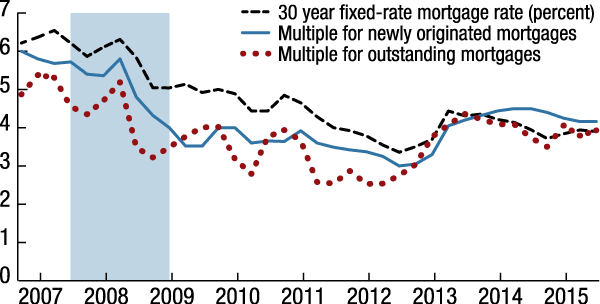
Note: Interest rates and multiples pertain to 30-year fixed-rate mortgages eligible for a guarantee from Fannie Mae or Freddie Mac. Shaded areas are NBER-defined recessions.
Sources: For the 30-year fixed-rate mortgage rate, Freddie Mac Primary Mortgage Market Survey; for the multiple for newly originated mortgages, Phoenix Capital, Inc; for the multiple for outstanding mortgages, OCC.
In the years preceding the financial crisis, large banking institution aggregators significantly increased their purchases of MSAs. During and after the financial crisis, large-banking institution aggregators revisited this business model in the wake of their large losses on loans originated through these channels, and instead focused on loans originated through their retail channel, as shown in figure 7. The decline of purchase activity on the part of large banking institution aggregators reduced the demand for MSAs, and put downward pressure on the multiple during the financial crisis.
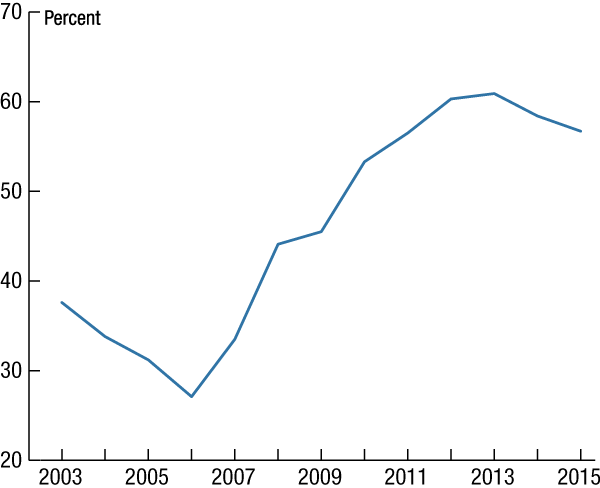
In addition to the decline in aggregator purchase activity, the other housing-market related events during the crisis, such as the sharp fall in house prices and significant increase in borrower defaults, put downward pressure on the multiple. One way to see this fact is to note that reported book values of MSAs held by banks decreased by 33 percent in the fourth quarter of 2008 alone, from about $76 billion to about $51 billion.57 Since the volume of one- to four-family residential mortgages serviced for others by these institutions increased during that quarter, in aggregate, all of the reduction in MSA value during the fourth quarter of 2008 appears to be attributable to value decreases and none appears to be attributable to a reduction in the volume of serviced mortgages.
Other factors have also affected the trends in the MSA multiple over time, including, as discussed later in this report, tighter servicing regulations, significant legal settlements involving large banking institutions, and increases in the cost of servicing. That said, the MSA multiple currently exceeds the lows reached in 2012, and generally moved sideways in the range of 3 to 4 during 2014 and 2015.
Changes in Outstanding Unpaid Principal Balance on Mortgages Serviced for Others
The fluctuations in the UPB component of bank MSA holdings stem from four main factors: mortgage debt outstanding, bank acquisitions of the assets of failed savings associations, the bank's decision whether to hold the loan in portfolio and retain the servicing, and the shift in servicing market share between banks and nonbanks. In turn, the market shares of banks and nonbanks have been affected by an assortment of regulatory changes.
Mortgage Debt Outstanding
House prices rose sharply from 1998 to 2006, then contracted substantially through 2011 (see CoreLogic HPI in figure 8). During the build up in housing prices until 2006, mortgage debt rose in part because borrowers needed larger loans in order to purchase more expensive homes, and in part because borrowers extracted equity from their homes in order to finance other purchases (see Mortgage Debt Outstanding in figure 8). Mortgage debt started decreasing in 2008, as new mortgage originations contracted because of a lack of credit supply and demand, while an unprecedented increase in foreclosures led to an extinguishment of mortgage debt.58
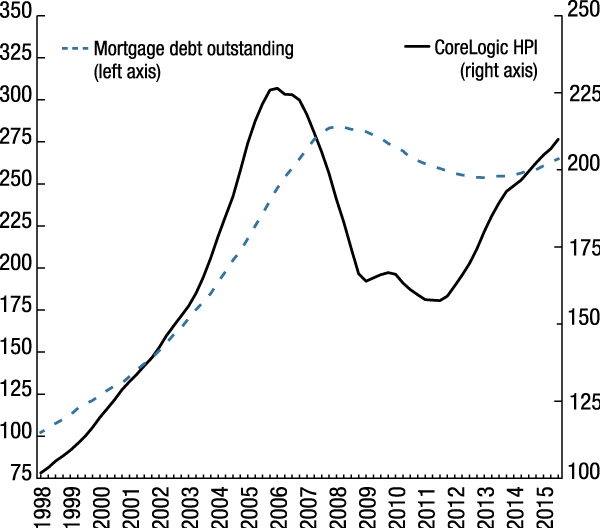
Note: Series are indexed to 100 in 1998:Q1. The house-price index is seasonally adjusted by Federal Reserve Board staff.
Sources: For house prices, CoreLogic; for mortgage debt outstanding, Federal Reserve Board, Statistical Release Z.1, "Financial Accounts of the United States."
Bank Acquisitions of the Assets of Failed Savings Associations
Savings associations were generally heavily invested in mortgage-related assets because the qualified thrift lender test required these institutions to have qualifying investments (including mortgage-related assets) equal to at least 65 percent of their portfolio assets.59 Savings associations that followed the "originate-to-distribute" model typically had particularly large concentrations in MSAs. Countrywide Bank, FSB and Washington Mutual Bank, FSB were two such savings associations that had large MSA holdings and were acquired by banks at the peak of the crisis. Effinity Financial Corporation (parent to Countrywide Bank, FSB) reported $18.4 billion in MSAs as of June 30, 2008, on its last TFR before acquisition. Similarly, Washington Mutual Inc. (parent to Washington Mutual Bank, FSB) reported $6.2 billion in MSAs as of June 30, 2008, on its last TFR before acquisition. Although some of these MSAs were sold or written off prior to acquisition, a meaningful amount of these assets were assumed by the acquiring bank and were reported in the acquiring banks' subsequent Call Reports. These acquisitions thus contributed to a spike in MSAs reported by banks between the second and third quarter of 2008.
Banks' Decision to Hold Loans in Portfolio
As shown in figure 9, the share of all loan originations that were securitized (as calculated by Inside Mortgage Finance) rose from 61 percent in 2006 to 89 percent in 2009. The first part of the rise (in 2006 and early 2007) was due to a substantial increase in activity in the private-label MBS market. After the housing bubble burst in 2007 and the private-label MBS market froze, mortgage securitizations guaranteed by the GSEs or Ginnie Mae rose, facilitated in part by an increase in the conforming loan limit, which is the maximum loan size eligible for FHA and GSE credit guarantees.60 Under the assumption that loans originated by banking institutions are securitized at a roughly similar rate as mortgage originations overall, the increase in securitization share from 2005 to 2009 likely contributed to the increase in MSAs recorded on banking institutions' books during that period.
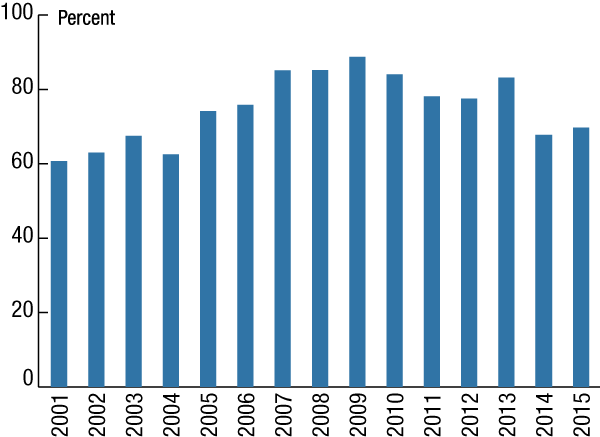
After the crisis, private capital began to re-enter the mortgage market, the conforming loan limit was lowered (in October 2011), 61 and the securitization rate gradually decreased. In 2014 and 2015, the securitization rate dropped to around 70 percent, in part because of ongoing growth in banks' originations of loans larger than the conforming loan limit, which banks largely held in portfolio. The lower securitization rate in 2014 and 2015 may have dampened MSA holdings by banks. That is, as banks hold a greater share of the mortgages they originate on their balance sheet, their holdings of MSAs may diminish.
Shift in Servicing Market Share between Banks and Nonbanks
The dollar volume of mortgages serviced by banking institutions rose until 2008 (the left panel of figure 10), reflecting the fact that mortgage debt overall peaked in 2008 and the fact that the banking institution market share of mortgage servicing increased from 2006 to 2008 (the right panel of figure 10).62 During the financial crisis, many nonbank lenders and servicers experienced significant funding strains and either scaled back their origination and servicing operations or left the business entirely. As the strains of the financial crisis eased, nonbank mortgage originators and servicers regained and then built upon their market share in both mortgage originations and mortgage servicing. Data collected under the Home Mortgage Disclosure Act (HMDA), for example, indicate that the share of home-purchase mortgages originated by independent mortgage companies rose from 23 percent in 2007 to 47 percent in 2014.63
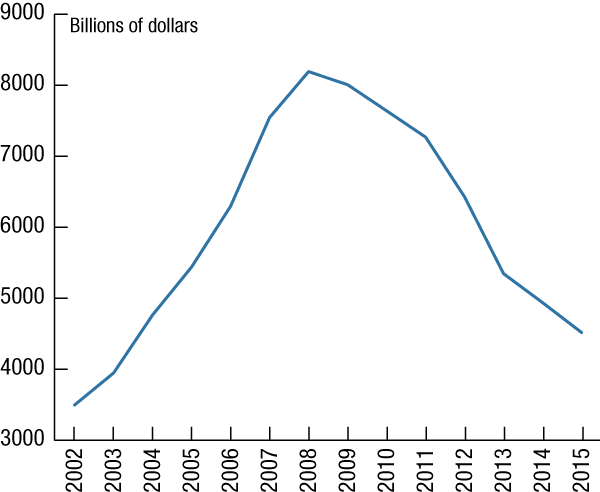
Note: Includes all loans serviced by firms, not just those serviced for others.
Source: Staff calculations from Inside Mortgage Finance data.
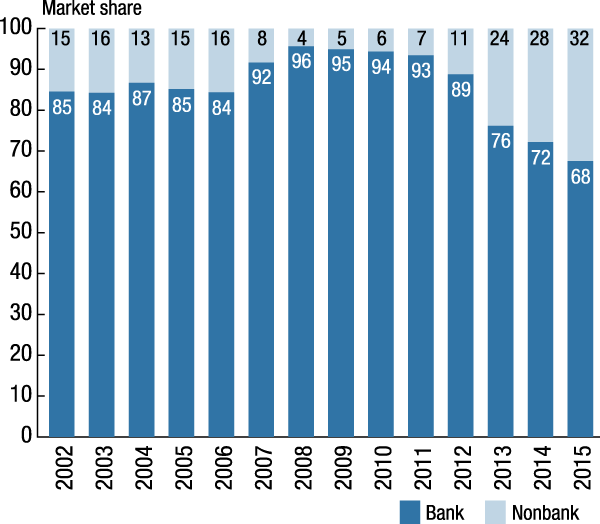
Note: Includes all loans serviced by firms, not just those serviced for others. Market share statistics are for each type of firm's share of mortgages relative to total mortgages serviced by the top 30 firms in each year.
Source: Staff calculations from Inside Mortgage Finance data.
Nonbanks also boosted their mortgage servicing market share through bulk purchases of MSAs. Many of these purchases were composed of portfolios related to nonperforming loans originally held by banking institutions, 64 most notably in 2013, when nonbank servicers purchased from banks in bulk sales the MSAs corresponding to more than $500 billion in mortgages.65 These sales included a $215 billion sale from Bank of America Corporation to Nationstar Mortgage LLC (Nationstar), a $93 billion sale from Bank of America Corporation to Walter Investment Management Corp. (Walter), an $87 billion sale from Ally Financial Inc. to Ocwen Financial Corp. (Ocwen), a $78 billion sale from OneWest Bank to Ocwen, a $40 billion sale from Flagstar Bank to Two Harbors Investment Corp., and a $9 billion sale from EverBank Financial Corp. to Walter.66 By 2015, roughly one-third of MSAs were held by nonbanks, whereas before the financial crisis, the nonbank share was around 15 percent.
Role that the challenges of servicing nonperforming loans had on the shift. As suggested by these bulk sales, banks' difficulties managing their portfolios of nonperforming loans appear to have played a key role in the growth of the nonbank servicer sector. Before the financial crisis, the mortgage servicing business was generally dominated by banking institutions and their affiliates, and was oriented toward handling large volumes of performing loans.67 This model began to show its weaknesses as the housing market deteriorated and the number of delinquent loans rose. Through the supervisory process and other means, the federal banking agencies had begun to identify widespread problems throughout the mortgage servicing market, such as accounts of poor communication with borrowers, lost information, improper or no documentation, and inadequate staffing. The increase in mortgage delinquencies and foreclosures that occurred during the financial crisis further highlighted servicing deficiencies. These weaknesses resulted in findings of unsafe and unsound practices, violations of applicable federal and state law and requirements, and widespread consequences for the national housing market and borrowers.68
In 2011, the Federal Reserve and OCC mandated improvements to servicing practices through enforcement actions against 10 banks.69 In 2012, further improvements were mandated through a legal settlement among the U.S. Department of Justice (DOJ), the U.S. Department of Housing and Urban Development, 49 state attorneys general, and 5 large bank mortgage servicers (DOJ settlement).70 These actions and settlements involved large civil penalties, including more than $25 billion in penalties and consumer relief under the terms of the DOJ settlement.
Banks' difficulties in servicing their nonperforming loans, in conjunction with these enforcement actions and settlements, appear to have motivated banks to sell MSAs to nonbanks. Nonbank servicers were willing to pick up much of this servicing, in part because of their cost advantage relative to bank servicers in handling nonperforming loans. That cost advantage stemmed from both their specialization in this type of servicing 71 and from their ability to harness technological innovations in order to reduce costs.72 The specialty servicers also got a boost from Fannie Mae's "High Touch Servicing Program," which was designed to facilitate the transfer of nonperforming loans from banks to specialty servicers.73
In January 2014, new servicing standards and requirements mandated by the Consumer Financial Protection Bureau (CFPB) became effective.74 These requirements applied to both banking institution and nonbank servicers, as the Dodd-Frank Act provided the CFPB with the authority to supervise banking institutions with assets over $10 billion and nonbank mortgage servicers, and to issue rules that addressed consumer protection issues in mortgage servicing.75 Under its authority under the Truth in Lending Act, as implemented by Regulation Z, and the Real Estate Settlement Procedures Act, as implemented by Regulation X, the CFPB issued rules that require changes in the notices and statements provided to borrowers, the way in which payments are credited, and servicer recordkeeping. The new rules also establish minimum standards that servicers must follow when handling delinquent mortgages or engaging in loss mitigation.
Although servicing conducted by banking institutions was the primary focus of regulatory scrutiny between 2011 and 2013, more recently servicing provided by nonbank servicers has been the subject of review by the CFPB, the Federal Trade Commission, and state regulators.76 The Financial Stability Oversight Council (FSOC), the Government Accountability Office, and Federal Housing Finance Agency's (FHFA) inspector general have also highlighted possible risks posed by nonbank servicers.77
Role of changes in the REIT tax treatment of excess MSAs. In 2013, the Internal Revenue Service (IRS) issued a private letter ruling (PLR) that provides an incentive for REITs 78 to invest in certain cash flows associated with MSAs.79 Servicers have the option of splitting their servicing revenue into two pieces: the "base servicing," representing the servicer's compensation for carrying out its servicing duties, and the "excess servicing," representing the revenue beyond the servicer's costs. The PLR established that the excess servicing spread portion of an MSA is a qualifying asset for a REIT and that the excess servicing strip is more similar to an interest-only mortgage strip than compensation for performing servicing.80 This clarification in tax treatment appears to correspond to an increased appetite on the part of REITs for investing in MSAs.
Trends in Banks' MSA Values Relative to Assets and to Capital
In this Section:
MSAs represent a very small share in the aggregate of total bank assets and CET1 capital. As illustrated in figure 11, the amount of MSAs relative to total assets during the 1998 to 2015 period ranged from nearly zero to 0.7 percent, and stood at 0.25 percent in 2015. Meanwhile, the amount of MSAs in relation to CET1 capital (or tier 1 capital less preferred stock and related surplus, prior to January 1, 2015) ranged from 2 percent to 9 percent during the 1998 to 2015 period, and was 2.8 percent in 2015.81
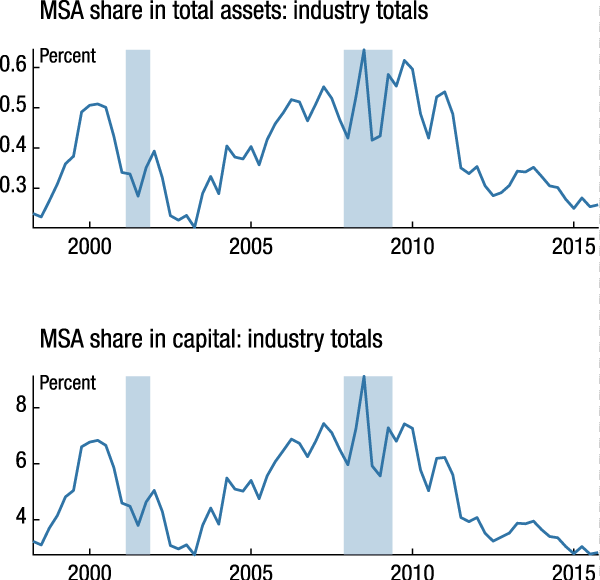
Note: Shaded areas are NBER-defined recessions.
Source: Staff calculations from Call Report data.
The time-series pattern of MSAs relative to total assets and to CET1 capital shown in figure 11 shares many of the same peaks and troughs as the time series of MSAs alone in figure 5. However, the MSAs to assets and to CET1 capital series have declined more sharply since 2008 than the MSA valuations alone. This fact suggests that the capital and the assets of banks have risen by more than MSA holdings since the financial crisis.
Although MSAs have become a smaller share of banking sector assets in the aggregate, the number of banks that held MSAs increased considerably during the period, from 513 in the second quarter of 1998 to 913 in the fourth quarter of 2015, as shown in figure 12. Figure 12 also shows that the share of banks with MSAs rose even more during this period--from 6 percent in 1998 to 16 percent in 2015--in part because the overall number of banks contracted significantly. The increase in the number and share of banks holding MSAs appears to have started accelerating around 2009.

Note: Shaded areas are NBER-defined recessions.
Source: Staff calculations from Call Report data.
Shifts between Small Bank and Large Bank Holdings of MSAs
That MSA balances have been decreasing while the number of banks holding MSAs has been increasing is due to the fact that large banks--which hold the majority of MSAs--are decreasing their holdings, whereas small banks--which make up the majority of banks that hold any amounts of MSAs--are increasing their holdings. On this point, figure 13 shows the MSAs to CET1 capital ratio for banks of four different asset sizes: less than $10 billion, between $10 billion and $50 billion, between $50 billion and $250 billion, and more than $250 billion. Of the four groups, banks with less than $10 billion in assets have, by far, the lowest MSAs to CET1 capital ratio. However, the aggregate MSAs to CET1 capital ratio for these banks has increased from less than 0.4 percent in 2009 to about 0.9 percent in 2015. Likewise, the share of total MSAs held by banks with less than $10 billion in assets also rose over that period, from less than 2 percent in 2009 to 8 percent in 2015. In contrast, banks with assets greater than $250 billion have seen a steady decline in MSA holdings since the third quarter of 2008, when they had an MSAs to CET1 capital ratio of 19 percent, compared with 4.4 percent at the end of 2015.
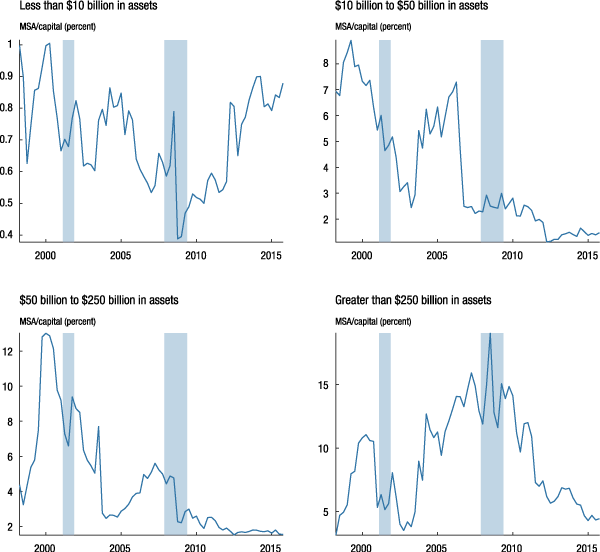
Note: Shaded areas are NBER-defined recessions.
Source: Staff calculations from Call Report data.
The increase in the MSAs to CET1 capital ratio for small banks and the decrease in the same ratio for all other banks could reflect differences between these two groups in either the multiple or the UPB of loans serviced for others. Data are not publicly available on MSA valuation multiple by bank size. However, data on the UPB of mortgages serviced by others seems to explain the differences in the MSAs to CET1 capital ratio. As shown in table 2, from 2010 to 2015, for example, the UPB of mortgages serviced for others declined by roughly $2 trillion, or about 40 percent, for banks with more than $250 billion in total assets. It increased by around $70 billion, or 44 percent, for banks with less than $10 billion in total assets.
| Asset size category | Total 1-4 family mortgages serviced for others reported by banks | |||
|---|---|---|---|---|
| Year-end 2010 |
Year-end 2015 |
Percent change | Number of banks in 2015 | |
| Greater than $250 billion | $4,819 | $2,928 | -39% | 6 |
| $50 to $250 billion | $545 | $418 | -23% | 26 |
| $10 to $50 billion | $213 | $163 | -24% | 48 |
| Less than $10 billion | $159 | $230 | 44% | 5,258 |
| Total | $5,736 | $3,739 | -35% | 5,338 |
Source: Staff calculations from Call Report data.
Distribution of Banks by MSAs to CET1 Ratios
Most banks--83 percent--hold no MSAs.82 The number of banks with no MSAs has decreased significantly since 1998, but that decline almost entirely reflects the contraction in the number of banks overall during this period. Of banks with MSAs, the vast majority--646 in 2015--held relatively small quantities, less than 3 percent of CET1 capital. As shown in figure 14, 120 banks have MSAs to CET1 capital ratios of 3 to 5 percent and 67 have MSAs to CET1 capital ratios of 5 to 8 percent. Finally, 19 banks have MSAs to CET1 capital ratios of 8 to 10 percent and 61 have ratios in excess of 10 percent. The number of banks in each of these categories has, on net, increased since 1998.
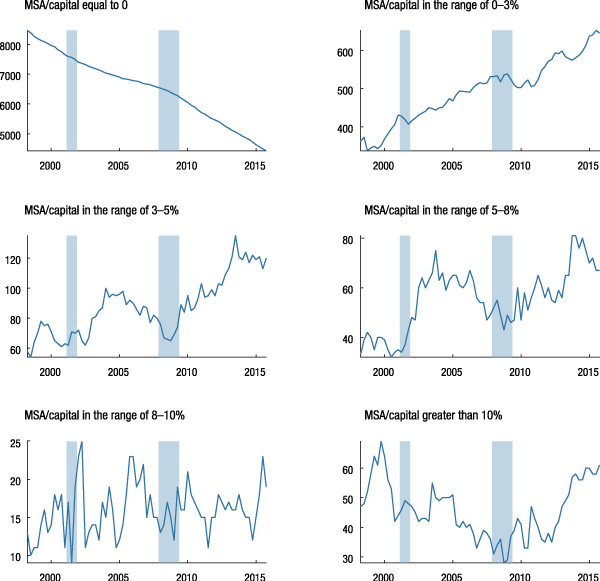
Note: Shaded areas are NBER-defined recessions.
Source: Staff calculations from Call Report data.
The increase in the number of banks with higher MSAs to CET1 capital ratios, however, masks a significant difference in the trends for small and large banks.Figure 15 shows the share of banks by asset size with MSAs that are more than 10 percent of their CET1 capital. The number of banks that have less than $10 billion in assets and MSAs to CET1 capital ratios in excess of 10 percent rose from 20 at the recent low point in the fourth quarter of 2008 to 58 in the fourth quarter of 2015. To put this rise in context, these 58 banks represent only about 1 percent of the 5,258 U.S. banks with assets less than $10 billion. In contrast, the number of banks with MSAs to CET1 capital ratios in excess of 10 percent has decreased significantly for banks with more than $10 billion in assets. In total, only 3 such banks currently have ratios of MSAs to CET1 capital in excess of 10 percent, compared with 11 at the recent high point in 2009. These banks represent about 4 percent of banks with assets greater than $10 billion.
Figure 15. Number of banks with MSAs to CET1 capital ratios higher than 10% by asset size, 1998-2015
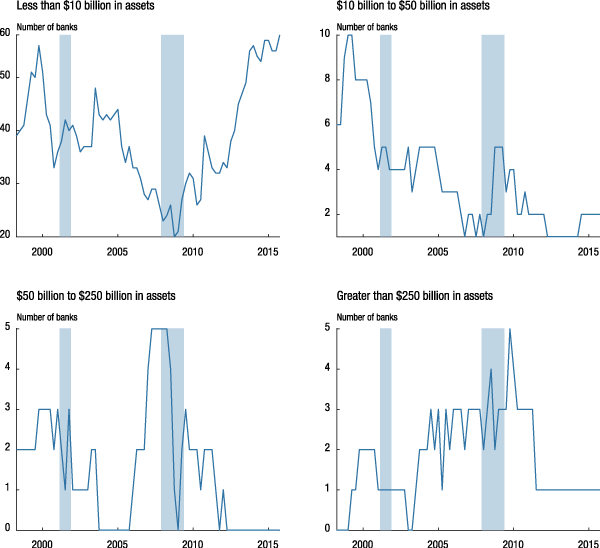
Note: Shaded areas are NBER-defined recessions.
Source: Staff calculations from Call Report data.
Reason for MSA Decreases among Large Banking Institutions
As discussed earlier in this report, much of the servicing contraction in large banking institutions appears related to banking institutions' desires to rid themselves of the servicing on nonperforming loans. The MSA treatment under the revised capital rule is unlikely to be a motive for the banking institution bulk sales of nonperforming loans because the MSA valuations for nonperforming loans tend to be low, and so selling the servicing on these loans may not be an effective way to reduce the MSAs to CET1 capital ratio.83 Some of the contraction also results from large banking institutions scaling back somewhat their mortgage origination activity more generally during the post-crisis period. For example, data reported by Inside Mortgage Finance indicate that the large banking institution 84 share of mortgages originated to purchase homes fell from 53 percent in 2008 to 28 percent in 2015.85 The overall amount of mortgages directly or indirectly financed by large banking institutions is more difficult to determine. Large banking institutions provide significant funding to some nonbank mortgage companies, and under some business models banking institutions source some of the mortgage loans that nonbank lenders originate.
Large reductions in servicing portfolios by large banking institutions were widespread after the crisis for the reasons described in this report, both for institutions whose MSA concentrations fell far short of the 10 percent deduction threshold and for those that exceeded it. Nonetheless, the decline in the number of large banks with MSAs to CET1 capital ratios in excess of 10 percent is partially explained by increases in capital levels at these firms during the last few years and suggests that large banks' economic incentive to avoid regulatory capital deductions resulting from MSAs above the 10 percent threshold is one of the factors that is influencing the amount and distribution of MSAs.
Reason for Increase in MSAs among Small Banks
As noted earlier, the number of banks with less than $10 billion in assets and MSAs to CET1 capital ratios higher than 10 percent has risen considerably since 2010. This increase appears to stem, in part, from at least two factors. First, unlike the trend for large banks, banks with less than $10 billion in assets have increased their mortgage origination market share from 13 percent in 2008 to 19 percent in 2014.86 Second, small banks appear to have switched their MSA business models after the financial crisis. During the housing bubble, some of the larger firms typically served as aggregators by purchasing loans and their accompanying servicing rights from smaller banks. The aggregator business was profitable, in part, because the GSEs charged lower guarantee fees 87 to firms that brought them larger quantities of loans.88 Aggregators, in turn, shared some of these cost savings with the smaller banks from whom they purchased loans.
During and after the financial crisis, aggregators pulled back sharply on their purchases of loans from smaller banks. This pullback reflected several factors. First, the guarantee fee pricing became less favorable to aggregators.89 Second, the GSEs began increasing their demands that banks repurchase loans that had performed poorly since being sold to the GSEs.90 Aggregators' losses on these repurchases were disproportionately concentrated among loans that they had purchased from other firms.91 Third, the revised capital rule, stricter mortgage servicing regulations, and the litigation experience of some banks may have dampened aggregators' interest in amassing large portfolios of MSAs.92
With the withdrawal of the aggregators from the market, smaller banks found it advantageous to sell their loans directly to the GSEs through the cash window.93 However, the GSEs, unlike the aggregators, do not purchase the servicing rights along with the underlying loans. Some of these smaller banks now appear to be retaining the servicing rights after selling the loans that they originate to the GSEs, and thereby recording an MSA, when they likely would not have done so with a sale to an aggregator.
To illustrate the shift in business strategy on the part of small banks, figure 16 shows the number and share of small banks that sold any loans to the GSEs in a given year. This calculation is based on data reported by lenders under HMDA.94 Between 2011 and 2012, the number of small banks that sold loans to the GSEs rose from 765 to 927, and remained around this level through 2014.95 This 150-bank increase in the number of small banks selling loans to the GSEs is roughly comparable to the increase in the number of banks recording an MSA during the same period.
Figure 16. Number and percent of banks with less than $10 billion in assets with any loans sold to Fannie Mae or Freddie Mac, 2004-14
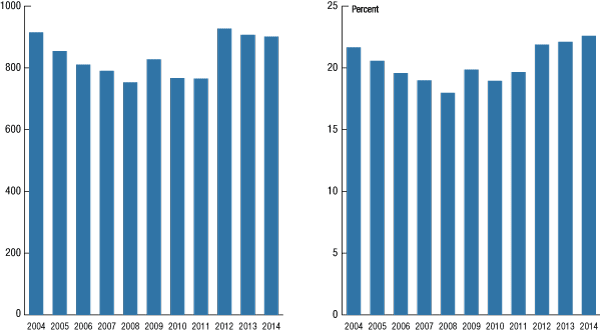
The HMDA data do not include information on whether any of these small banks retained the servicing rights after selling the loan to the GSEs. However, separate data from Freddie Mac suggest that the selling bank typically has retained the servicing, particularly in recent years. An important caveat is that these results are based on sellers and servicers with market shares greater than 1 percent, as the identity of smaller sellers and servicers is masked in the Freddie Mac data. Thus, these results may not reflect fully the behavior of small banks. That said, as shown in figure 17, the share of loans securitized by Freddie Mac in which the selling bank retained the servicing rose from around 65 percent in 2007 to nearly 100 percent by 2011, and has held steady around that level since.
Figure 17. Percentage of loans sold to Freddie Mac in which the selling bank retained the servicing, 2006-15
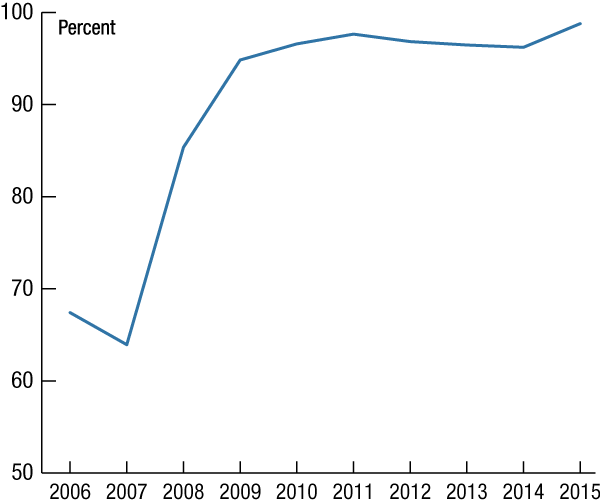
Source: Staff calculations from Freddie Mac loan-level disclosures.
References
50. This analysis is based on Call Report data for all insured depository institutions for 1998:Q2 to 2015:Q4, excluding savings associations. Banks began reporting CET1 capital on the Call Reports starting January 1, 2015; the report uses tier 1 capital less preferred stock and related surplus as a proxy for CET1 for data prior to January 1, 2015.
Under the revised capital rule, a banking organization may net DTLs associated with MSAs against its MSAs, thereby reducing the impact of the revised capital rule's MSA deduction approach. Although several banking institutions reported significant amounts of DTLs associated with MSAs on their public financial reports, the information needed to estimate MSAs net of associated DTLs is not readily available in the regulatory reports of the agencies (i.e., the Call Report and FR Y-9C) for most banking institutions. Therefore, this offset was not considered in all of the calculations in this report and, as a result, the MSAs to CET1 capital ratios included in this report may be overstated. Return to text
51. Our estimates throughout this report are based on the fair value of MSAs. The book value results are very similar to their fair value counterparts. Return to text
52. MSAs in federally insured credit unions have grown from $332 million in 2004 to $1.3 billion as of December 31, 2015. Return to text
53. The Dodd-Frank Act streamlined the supervision of depository institutions and their holding companies by abolishing the OTS and transferring its regulatory and rulemaking authority to the Federal Reserve, OCC, and FDIC. Enhancing Financial Institution Safety and Soundness Act of 2010, Title III of the Dodd-Frank Wall Street Reform and Consumer Protection Act, Pub. L. No. 111-203, § 300, 124 Stat. 1376, 1520 (2010). Return to text
54. These estimates were provided by Phoenix Capital, Inc. (Phoenix), a mortgage banking advisor that specializes in mortgage servicing rights. Phoenix has collected this data to represent an average multiple of the service fee for a co-issue/concurrent delivery of a 25 basis point strip of GSE 30-year fixed rate servicing. Phoenix makes no representations or warranties on the completeness of this data. Return to text
55. These data are collected by the OCC. Return to text
56. The mortgage rate shown is the one collected in the Freddie Mac Primary Mortgage Market Survey, available at www.freddiemac.com/pmms/index.html ![]() . Return to text
. Return to text
57. Declines in the fair value of MSAs, which are also reported on bank Call Reports, were almost identical. Return to text
58. Neil Bhutta, "The Ins and Outs of Mortgage Debt during the Housing Boom and Bust," Journal of Monetary Economics 76, (2015): 284-298. Return to text
59. 12 USC 1467a(m). Return to text
60. Robert Dietz and Natalia Siniavskaia, "GSE and FHA Loan Limit Changes for 2011: Scope of Impact ![]() ," National Association of Home Builders, June 1, 2011. Return to text
," National Association of Home Builders, June 1, 2011. Return to text
61. Ibid. Return to text
62. The estimates described in this section are based on data provided by Inside Mortgage Finance. These data include all loans serviced by a firm, not just those for whom the firm recorded an MSA. "Banking institution" for the purposes of the calculations based on Inside Mortgage Finance data is defined to include insured depository institutions, BHCs, savings and loan holding companies, and credit unions. The Inside Mortgage Finance data have varied over time in the number of mortgage servicers contained in its lists. To maintain comparability over time, the statistics shown here are based on the top 30 servicers in each year. Statistics based on a larger number of servicers (in the years when available) show a similar pattern to the top-30 statistics. The market share statistics refer to the banking institution and nonbank share of mortgages serviced by the top 30 holders and not each type of institution's share of the entire market. For an estimate of nonbank servicer market share relative to the entire mortgage servicing market, see Government Accountability Office, Nonbank Mortgage Servicers: Existing Regulatory Oversight Could Be Strengthened, GAO-16-278 (Washington, DC: 2016), 9. Return to text
63. Statistic from Neil Bhutta, Jack Popper, and Daniel R. Ringo, "The 2014 Home Mortgage Disclosure Act Data," Federal Reserve Bulletin101, (November 2015): Figure 8. In the HMDA data, only mortgages that a lender originates through its retail or broker channels are recorded as originations for that lender. In contrast, the Inside Mortgage Finance data include in a lender's originations mortgages originated through retail and broker channels, as well any mortgages that a lender sources through its correspondent channels. As a result, market share statistics based on HMDA data may differ from those based on Inside Mortgage Finance data. Return to text
64. "Nonbanks Continue Expanding Their Share of Mortgage Servicing Market at Evolutionary Pace," Inside Mortgage Finance, November 7, 2014, 3. "Some of the decline reflects the slow evaporation of the supply of mortgage debt outstanding, but it mostly is the result of handing off distressed servicing to firms designed to handle such assets and the Basel III restrictions on MSR that are on the horizon." Return to text
65. Kroll Bond Rating Agency, "Update - Residential Loan Origination and Mortgage Servicing Sector," April 9, 2015. Return to text
66. Ibid. Return to text
67. Lee , Nonbank Specialty Servicers, 2-3. Return to text
68. Board of Governors of the Federal Reserve System, Office of the Comptroller of the Currency, and Office of Thrift Supervision, "Interagency Review of Foreclosure Policies and Practices," April 2011. Return to text
69. Office of the Comptroller of the Currency, "OCC Takes Enforcement Action Against Eight Servicers for Unsafe and Unsound Foreclosure Practices," news release, April 13, 2011; Board of Governors of the Federal Reserve System, news release, April 13, 2011. Return to text
70. U.S. Department of Justice, "Federal Government and State Attorneys General Reach $25 Billion Agreement with Five Largest Mortgage Servicers to Address Mortgage Loan Servicing and Foreclosure Abuses," news release, February 9, 2012. Return to text
71. Kaul and Goodman, Nonbank Servicer Regulation,1-3 ."Banks, having encountered very low delinquencies historically, didn't have much experience servicing large volumes of delinquent loans and were therefore ill-prepared for this task. Nonbanks...were better situated to respond to the changing landscape." Return to text
72. Marshall Lux and Robert Greene, "What's Behind the Non-Bank Mortgage Boom?" Harvard Kennedy School, M-RCBG Associate Working Paper Series no. 42: 25-31 (June 2015) ![]() . Return to text
. Return to text
73. Lee, Nonbank Specialty Servicers, 2; and Federal Housing Finance Agency, Evaluation of FHFA's Oversight of Fannie Mae's Transfer of Mortgage Servicing Rights From Bank of America to High Touch Servicers, EVL-2012-008 (Washington, DC: 2012). Return to text
74. Mortgage Servicing Rules Under the Real Estate Settlement Procedures Act (Regulation X), 78 Fed. Reg. 10,695 (February 14, 2013), as amended by 78 Fed. Reg. 44,685 (July 24, 2013), 78 Fed. Reg. 60,381 (Oct. 1, 2013), and 78 Fed. Reg. 62,993 (Oct. 23, 2013). Mortgage Servicing Rules Under the Truth in Lending Act (Regulation Z), 78 Fed. Reg. 10,901 (February 14, 2013), as amended by 78 Fed. Reg. 44,685 (July 24, 2013), 78 Fed. Reg. 60,381 (Oct. 1, 2013), and 78 Fed. Reg. 62,993 (Oct. 23, 2013). Return to text
75. The specific authorities exercised by the CFPB stemmed from the Truth in Lending Act, as implemented by Regulation Z, and the Real Estate Settlement Procedures Act, as implemented by Regulation X. Return to text
76. For example, see Federal Trade Commission, "National Mortgage Servicing Company Will Pay $63 Million to Settle FTC, CFPB Charges," news release, April 21, 2015. Return to text
77. Financial Stability Oversight Council, 2014 Annual Report (Washington, DC: 2014), 10; Nonbank Mortgage Servicers; and Federal Housing Finance Agency, FHFA Actions to Manage Enterprise Risks from Nonbank Servicers Specializing in Troubled Mortgages, AUD-2014-014 (Washington, DC: 2014), 4-5. Return to text
78. A REIT is a company that is required to hold passive investments in real estate and real estate-related assets and make certain distributions in order to maintain a tax-advantaged status. The tax advantage associated with REITs is that the income is taxed only at the level of the investor, and not subject to an additional level of taxation at the trust level. Return to text
79. Internal Revenue Service, Ltr. Rul. 105442-12 (May 24, 2012). Return to text
80. In most circumstances the interest-only strip that results from the excess servicing is not treated as a separate asset for regulatory capital purposes. In certain discrete instances, however, an interest-only strip may be recognized apart from the related MSA. This recognition can occur, for example, when the parties to the contract associated with the MSA renegotiate to lower the servicing fee, thus separating the original MSA into two components. The agencies understand that this practice is not common. Moreover, while an interest-only strip and an MSA are both subject to similar risks, such as prepayment risk and default risk, an interest-only strip and an MSA differ in important ways. Primarily, an interest-only strip is a passively owned financial asset, whereas the holder of an MSA must perform specific activities and obligations related to the servicing. Return to text
81. Since NCUA started collecting MSA data in 2004, the highest levels of the MSAs to assets ratio and the MSAs to net worth ratio were 0.2 percent and 1.96 percent, respectively. Return to text
82. Ninety-two percent of federally insured credit unions do not hold MSAs, and of those with MSAs over 90 percent have MSAs to net worth ratios of less than 5 percent. Return to text
83. Laurie Goodman, "Servicing Costs and the Rise of the Squeaky Clean Loan ![]() ," Mortgage Banker, February 2016, 2-3. "MSRs tend to have the lowest value when the borrower is higher risk and the property is located in a long-timeline judicial state." Return to text
," Mortgage Banker, February 2016, 2-3. "MSRs tend to have the lowest value when the borrower is higher risk and the property is located in a long-timeline judicial state." Return to text
84. For purposes of this calculation, a large banking institution is a BHC with assets greater than $250 billion. Return to text
85. The corresponding shares in the HMDA data for banks with assets greater than $250 billion are 31 percent in 2008 and 12 percent in 2014 (the most recent year of data available). The HMDA shares are lower for large banks because HMDA only counts mortgages that a lender sources through its retail or broker channels as originations for that lender. Mortgages that a lender sources through its correspondent channel are counted as originations of the correspondent lender. The Inside Mortgage Finance data, in contrast, attribute to a lender loans sourced through its correspondent channel. Return to text
86. This calculation is based on HMDA data. Return to text
87. The GSEs charge lenders a fee to compensate the GSEs for their costs in taking on the credit risk of the loan. Return to text
88. Federal Housing Finance Agency, Recent Trends in the Enterprises' Purchases of Mortgages from Smaller Lenders and Nonbank Mortgage Companies, EVL-2014-010 (Washington, DC: 2014), 14. Return to text
89. Federal Housing Finance Agency, "FHFA Announces Increase in Guarantee Fees," news release, August 31, 2012. Return to text
90. Recent Trends, 16. Return to text
91. Ibid. Return to text
92. Ibid. Return to text
93. The cash window refers to the manner by which the GSEs buy individual loans directly from mortgage originators. Return to text
94. The calculation is restricted to mortgages originated in the first nine months of the year. Some loans that are originated in the fourth quarter of the year are not sold until the next calendar year, so calculations that include loans originated in that quarter may understate the share of loans that are sold. Return to text
95. This calculation may understate the number of small banks that shifted their strategy, because banks with assets under a certain threshold and banks that operate only in rural areas are not required to report their loan originations under HMDA. The share of larger banks that sold loans to the GSEs also increased during this period; these data are not shown because only a few banks are in this category. Return to text
